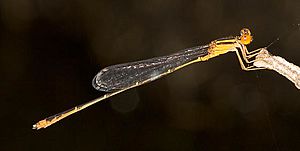Orange bluet
Quick facts for kids Orange bluet |
|
|---|---|
 |
|
| Scientific classification | |
| Kingdom: | |
| Phylum: | |
| Class: | |
| Order: | |
| Suborder: | |
| Family: | |
| Genus: |
Enallagma
|
| Species: |
E. signatum
|
| Binomial name | |
| Enallagma signatum (Hagen, 1861)
|
|
The orange bluet (Enallagma signatum) is a type of damselfly. It belongs to the Coenagrionidae family, which includes many small, colorful damselflies. This insect is known for its bright orange color.
Contents
Discovering the Orange Bluet
The orange bluet is special because of its bright orange color. This makes it easy to spot among other damselflies.
How to Identify Male Orange Bluets
Male orange bluets have an orange body section called the thorax. This is where their wings and legs are attached. A thick black stripe runs down their back, and they have black stripes on their shoulders.
Their abdomen (the long tail-like part) is mostly black. It has some orange rings and is orange underneath. The tip of the abdomen is also orange. Their large eyes are orange, set on a black head. Small orange spots behind their eyes are connected by an orange bar.
How to Identify Female Orange Bluets
Female orange bluets look similar to males. However, their thorax is a dull yellow instead of bright orange. Their abdomen is mostly black on top and dull yellow underneath.
Their large eyes are yellow-brown. They have small yellow spots behind their eyes, connected by a thin yellow bar. Females can also come in three different colors: some stay blue, some turn green, and others become orange.
Where Orange Bluets Live
Orange bluets are often found near water. They like streams, ponds, and pools with still water. You can also find them near slow-moving streams and rivers.
Where Orange Bluets Are Found
Orange bluets live in parts of North America.
Orange Bluet Distribution in the United States
Orange Bluet Distribution in Canada
Size of the Orange Bluet
The orange bluet is a small insect. It usually measures about 1 to 1.5 inches (25–38 mm) long. Its hindwing, which is one of its back wings, is typically 15–21 mm long.
What Orange Bluets Eat
Orange bluets are predators. They feed on other insects. They fly slowly, moving in and out of plants that grow in the water. This helps them catch their prey.
Orange Bluet Habits
Orange bluets like to rest on different surfaces. You might see them perching on rocks or leaves. They also land on water lilies and other plants growing in the water. Sometimes, they even rest on the bare ground along the shore. When they perch, they usually keep their wings together.
Similar Damselfly Species
Some other damselflies look a bit like the orange bluet.
- Cherry, Burgundy, and Scarlet Bluets: These bluets are similar in shape but are red, not orange.
- Vesper Bluets: These are similar, but they have a much smaller or missing black stripe on their side.
- Threadtail Damselflies: These are also orange and can be found in the same areas. However, their abdomens are much longer and thinner. Their abdomens are twice as long as their wings.
- Florida Bluet: This damselfly is also orange and looks quite similar to the orange bluet.
Orange Bluet Reproduction
Female orange bluets can show when they are not ready to mate. Females often stay away from the water's edge. You usually only see them when they are mating or flying together with a male.
After mating, the male and female will lay eggs. They place the eggs in floating plants or other debris in the water. The male often goes underwater with the female. The female can stay underwater for up to 20 minutes while laying her eggs.
Orange Bluet Flight Season
The orange bluet has a long flight season. This means they can be seen flying for many months. Their season lasts from early March to early November. This damselfly is unusual because it is most active in the late afternoon.

